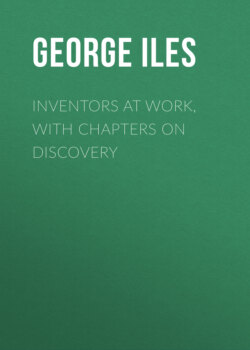Читать книгу Inventors at Work, with Chapters on Discovery - George Iles - Страница 13
Palladio’s Long Neglected Truss.
ОглавлениеThe queen-post truss was remarkably developed by Palladio, a famous Italian architect of the sixteenth century. Two of his designs, here given in outline, are from his work on architecture published in 1570; their contours, little changed, are in vogue to-day. Strangely enough the trusses of Palladio, for all their merit, passed out of notice until their principles were revived and improved by Theodore Burr, in 1804, in a wooden bridge over the Hudson at Waterford, New York. This bridge had spans respectively of 154, 160 and 180 feet, stretches impossible to single wooden beams. Professor J. B. Johnson, an eminent engineer, says that this is the most scientific design ever invented for an all-wooden bridge; during fifty years it stood unrivaled as a model for highway purposes in this country. The Burr bridges were usually covered in, so as to resemble the roofs we began by inspecting. In a truss bridge each part bounded by two adjacent uprights, as DOEH in the queen-post figure on page 21, is a panel; every part under compression, as DO, HE, is a strut, post, or column; every part subject to tension as DE, HO, is a tie.
Burr Bridge, Waterford, N. Y.
DO, HE, struts. DE, HO, ties. DHEO, panel.
In 1830 as the first American railroad train sped on its way, a new era dawned for the bridge builder as well as for his neighbors. At once sprang up a demand for bridges longer and stronger than those which in the past had served well enough. A score of wagons laden with wheat or potatoes were a good deal lighter than a locomotive followed by a train of loaded freight cars. A market-wagon, too, could easily be taken aboard a ferry-boat, but for an engine and its cars a bridge was imperative, if the stream were not so wide as to forbid all opportunity to the bridge builder. His response to the demands of the railroad was two-fold. First in the use of metal instead of wood, beginning with iron rods to bind together frames of timber. As iron became cheaper and its value more and more evident, he employed it for additional parts of his structure until at last he built the whole bridge of iron.
To-day good steel is so cheap that railroad bridges are seldom reared of anything else. Besides using stronger materials, the designer has gradually improved the form of his structure, not only in its parts but as a whole, so that to-day, strength for strength, a bridge may be only one tenth as heavy as a bridge of fifty years ago. Advances in form have been due to experience as one type has been compared with another; meanwhile the mathematicians have carried their analysis of strains as far as the extreme complexity of their problems will allow, greatly to the betterment of designs.
In building a bridge, as in rearing many other structures, girders of various contours are used. In bridge building the I-beam is most employed. When the roadway proceeds on the top chord, as DH, in the queen-post figure, page 21, we have a deck bridge; when it is built on the bottom chord, as CM, we have a through bridge.
